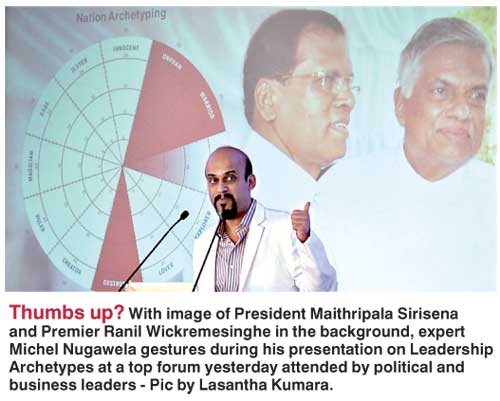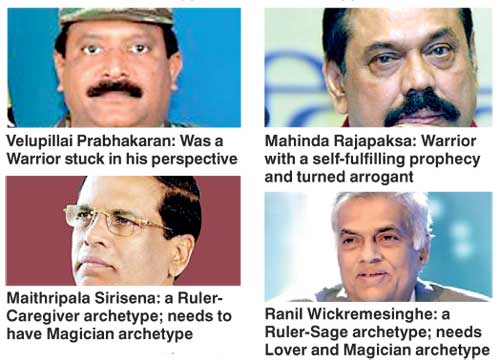Friday Nov 28, 2025
Friday Nov 28, 2025
Tuesday, 26 May 2015 02:18 - - {{hitsCtrl.values.hits}}
What are the probable archetypes of some of our political leaders? This was aptly explained by expert Michel Nugawela yesterday at a VIP CEO Forum over breakfast when he introduced Leadership Archetyping, the first of its kind in Asia.
He revealed 12 archetypal dimensions of leadership transformation, each with its own motivational needs and perspective. The 12 archetypes are Innocent, Orphan, Warrior, Caregiver, Explorer, Lover, Destroyer, Creator, Ruler, Magician, Sage and Jester and they reflect the various roles that leaders can play within organisations by putting a human face to the attitudes, interactions, and behavioural patterns that are correlated with success and thereby influence their effec tiveness. These archetypes also have negatives and positives.
tiveness. These archetypes also have negatives and positives.
He also said archetypes manifest themselves in societies, countries and companies.
He stated that during the past 30 years of civil war, Sri Lanka experienced the “Destroyer” archetype, which left many people “Orphaned” and led to strong “Warriors” commanding power and control in society.
Nugawela said that in 2009 Mahinda Rajapaksa was all powerful; a victorious ruler who won the war but eventually lost the peace. How did this happen? According to Nugawela, after 30 years of Warrior status, bloodshed and violence, what Sri Lanka needed was a complete shift, a ruler who would heal the wounds of the country, a ruler who would create prosperity.
“Unfortunately Mahinda Rajapaksa was stuck in his ‘Warrior’ archetype and could not produce the change needed for the country,” Nugawela said, adding that when faced with challenging situations it was difficult to change perspectives for the better.
Highlighting a popular slogan of former President Rajapaksa, ‘We will not dance to the tune of the West’, Nugawela said Rajapaksa was possessed by the energies of a Warrior, very aggressive.
“The plot of a warrior is fascinating. It is called, “Hero, Villain and Victim,” which is a self-fulfilling prophecy. Rajapaksa was a hero, the villain was the West, Diaspora and others, and the victim was the people. The emphasis was ‘You are bad, I am good, you are wrong, and I am right’ which went on to develop a superiority complex,” explained Nugawela.
According to him the negative shadow archetype of this warrior was looking out to be number one and dividing people into good and bad, and the belief that might was right and that justice should be put out of the window and overall energy was not related to a larger social purpose.
“When you have this perspective, you become very arrogant, you fall from power. This is because there are other high level warriors who could take the former down,” recalled Nugawela.
 Emphasising that he wasn’t stating whether one or the other was right, Nugawela said on 8 January the setting was - for the last 30 years, Sri Lanka has been a ‘Destroyer’ archetype due to the war which produced lot of ‘Orphan’ archetypes - deeply disillusioned, and pessimistic about life. In that situation, we needed to have very strong ‘Warriors’ to challenge.”
Emphasising that he wasn’t stating whether one or the other was right, Nugawela said on 8 January the setting was - for the last 30 years, Sri Lanka has been a ‘Destroyer’ archetype due to the war which produced lot of ‘Orphan’ archetypes - deeply disillusioned, and pessimistic about life. In that situation, we needed to have very strong ‘Warriors’ to challenge.”
“Those who voted for Rajapaksa were Orphans affected by the war, they were Warriors who were concerned that if Sri Lanka let go of a strong assertive ruler like Rajapaksa the country would return to a ‘Destroyer’ negative situation. The other half who voted were people who wanted to heal wounds, high level ‘Caregivers’, for the nation to get together, high level ‘Explorers’ and ‘Creators’ who wanted a better future.
In that context people chose Maithripala Sirisena, who is a Ruler-Caregiver and Ranil Wickremesinghe, a Ruler-Sage, into power.
Nugawela said Ranil was aware people had different perspectives and could bring balance. “The shadow (negatives) for the sage is you are cut off, unfeeling and disconnected from the people. Therefore Ranil needs to learn to build a ‘Lover’ and ‘Magician’ archetype which creates charisma. He needs to balance with other archetypes,” emphasised Nugawela.
“Maithripala is the Ruler-Caregiver who is talking about cooperation, compassion and the healing of wounds. Ranil is the Ruler-Sage, bringing wisdom and far-sighted perspective to change the country. The question is whether either of them can become Magicians to change and transform Sri Lanka.
Earlier on Nugawela also said that the LTTE supremo Vellupillai Prabhakaran was a “Warrior” stuck in his perspective and the then-Army Commander General Sarath Fonseka was a “Magician”, who changed his perspective.